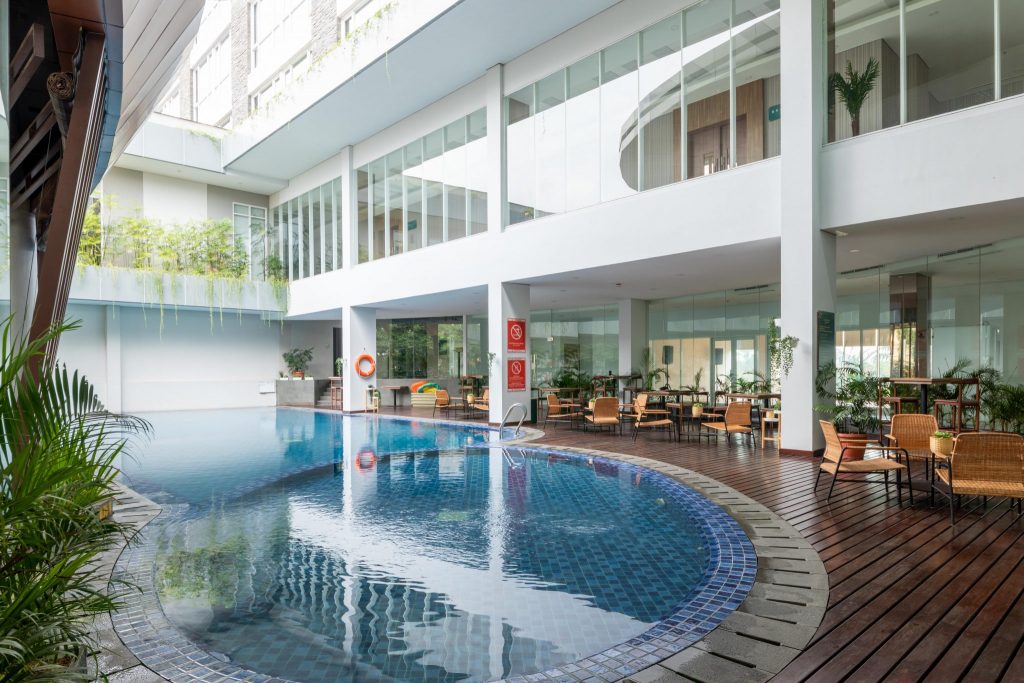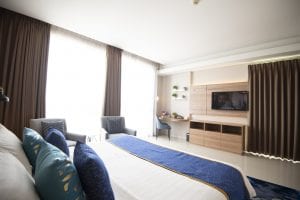Skift Take
A new brand, Sunerra, takes RedDoorz into the midscale arena of three and four stars hotels. Not only that, it will manage these hotels. Can RedDoorz do it, or will the move dilute its focus as a budget player and eat up resources?
A move by RedDoorz into the midscale hotel segment, and on a management contract basis, takes the Southeast Asian budget hotel chain on a new trajectory. But it’s one that seems fraught with risks.
RedDoorz has launched its first Sunerra hotel, a four-star property in Cikarang, 35 kilometers east of Indonesia’s Jakarta, owned by Global Pilar Sukses. The hotel has 142 rooms, including suites and executive rooms, swimming pool, spa, fitness center and a ballroom that fits 400 people, among others.
This, from the humble one-star RedDoorz hotel, which has up to 30 rooms and no amenities. With budget properties, all that is required is a branding and technology stack for distribution, and no management on RedDoorz’s part.
Increasingly, RedDoorz is looking more like the traditional hotel chain with multi-brands. Sunerra came after Sans, which it launched in November last year as a “design-inspired economy lifestyle brand.” In February 2020, RedDoorz also introduced KoolKost, an extended stay co-living brand.
The six-year-old startup now talks about being “the largest hospitality company in South-east Asia.” The brand expansion is part of this vision, said founder and CEO, Amit Saberwal.
He said having dealt with Covid-19 challenges, RedDoorz is “ready for the next phase of growth” by expanding offerings to asset owners other than budget. The pandemic forced the company to make strategic cost reductions last year. It also changed its business model of giving minimum guarantees to property owners. Plans to expand in Thailand were dropped in favor of continued focus on four core markets, Indonesia, Philippines, Singapore and Vietnam.
Saberwal said there’s no pressure from investors to expand into midscale. The move is driven by new opportunities arising from the pandemic, which has made owners realize the value brands bring, and changed customer behaviors, he said.
“Gone are the days people want contact; they want touchless. In the face of a crisis, individual asset owners see the collective power of being in a group, for example, how we worked with governments on hygiene certification which, individually, is hard to do,” said Saberwal.
It’s the hotels in the mid market that bore the brunt of Covid-19 most, he said. “Large properties could refinance their loans. Small properties own their assets and don’t need us to run them. It’s the commercially-run 2.5 to 3.5 stars that are screwed and these are the ones that are more amenable to our offering,” said Saberwal.
Difficult to Disrupt
Few hotel chains can refuse new opportunities, in fact it’s why brands keep proliferating even though only a handful make a real difference.
And that, is the first problem for Sunerra. Unlike budget, which needed the disruption that players such as RedDoorz, Oyo and others have done, little reinvention can be made in the mid market, as seen with the incremental improvements in this category through the years.
Moreover, the mid market in all South-east Asian countries is “likely the most competitive hotel segment, with a plethora of international, regional and local brands fighting for share in each market,” said Andrew Langdon, Accor’s senior vice president, South-east Asia, Japan and Korea.
“It is very difficult to compete with established operators and brands in the market that have strong supporting corporate structures, distribution and loyalty programs,” said Langdon. “All operators are consistently upgrading and enhancing technology to deliver more efficiencies and distribution. At the end of the day, the margins are under pressure by virtue of low rates. Without scale, viability is limited.”
On RedDoorz’s website, a one-night stay in a deluxe twin room on June 22 at the Sunerra Antero Jababeka costs only $27 net.
The hotel, developed in 2016 and opened as a Horison then Antero, wasn’t on Accor’s radar because the location is “challenging,” said Langdon. Accor operates an Ibis Styles Cikarang, which is nearby.
Similarly, Norbert Vas, vice president business development of Archipelago International, Indonesia’s top chain, said, “It [Sunerra Antero] is a decent hotel with potential, but to our knowledge, the Cikarang market is struggling with oversupply.”
Archipelago runs three hotels in the area, a two-star Favehotel, a three-star design-centric Harper and a three-star meetings-focused hotel, Quest. “We are doing ok. Harper’s RevPAR [revenue per available room] leads in its competitive set but, even then, occupancies are between 50 and 70 percent and rates are suppressed.
“We have a great deal of respect for RedDoorz, but if you start a new brand, you must make sure the first few properties can act as ambassadors and showcase the attributes of the brand. The choice of location is immensely important,” said Vas, who is instrumental in Archipelago’s growth to a portfolio of 154 hotels and 20,853 rooms under nine main brands (excluding sub-brands in each).
Infrastructure
Archipelago started in the opposite way of RedDoorz, as a four-star operator with the Aston brand 24 years ago. Only after amassing experience in managing hotels and building the required infrastructure did it venture into the two-star market with Favehotel, then the budget Neo brand.
The chain is still predominantly in Indonesia with 147 hotels in operation, the rest are in the Philippines, Malaysia, Cuba and Dubai. It is expanding to Saudi Arabia with seven hotels signed and has another five hotels coming up in Cuba and 12 in the Philippines.
It’s companies like Archipelago, Tauzia, Swiss-Belhotel International, Accor and IHG that are strong in the mid market in South-east Asia that RedDoorz is up against.
To compete, RedDoorz will have to create a viable brand image that is fueled by properties delivering on the brand image and promise, said Robert Hecker, managing director Pacific Asia, Horwath HTL.
Hecker also points out the irony that RedDoorz is getting into management when most hotel management companies in Asia are working on how they can get bigger into franchising.
“It’s generally acknowledged that franchising yields better margins for hotel companies than management contracts, which come with all the added corporate office overheads associated with hotel management.
“There’s definitely risks involved for RedDoorz with adding such management infrastructure, particularly when associated with properties with lower ADRs [average daily rates] and revenues that can’t generate much in the way of management fees. The risk versus reward doesn’t really seem worthwhile.
“RedDoorz and others like them attracted capital on the basis of their technology-based distribution model, whereas management is still very much not technology based,” said Hecker.
Technology Company
But perhaps that is where RedDoorz can make a difference in midscale, for instance, reducing labor costs through contactless service and increasing demand through its proprietary technology.
Saberwal said RedDoorz will remain a technology company and the move into midscale is also a “technology play.”
“The fact is we have a lot of technology that is in-house. We drive 75 percent of business directly. So feedback is from our own use cases and not a third party. Thus we are able to be hyper-local and map out demand,” said Saberwal.
“Our technology should cover 80 percent of all accommodation types, i.e., leaving out the 4.5 to five stars.”
Another possible difference is in the management fee structure. “We make money when the property makes money. None of the other brands do that. First, they take. Before the hotel opens, the hotel management company takes a sign-up fee, branding fee, technical fee and other fees.
“Our fees are much smaller at the start, then there’s some backloading of fees based on performance. It’s a structure that brings more value to owners,” said Saberwal.
“There are thousands of unflagged hotels in Asia. We will create our own brand and our own differentiation. Only time will tell what the eventual vision of the [Sunerra] brand is.”
Have a confidential tip for Skift? Get in touch
Tags: budget hotels, midscale
Photo credit: This is a RedDoorz hotel: The first Sunerra, a new midscale brand. Photo: RedDoorz

